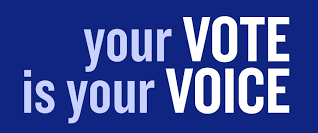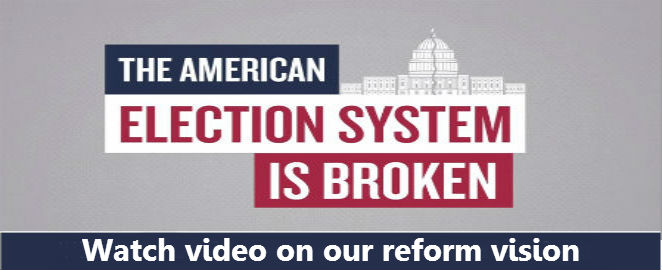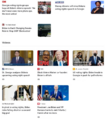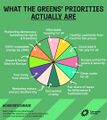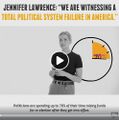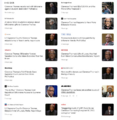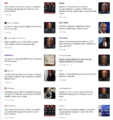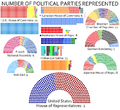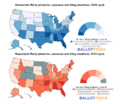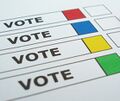Category:Electoral System Reform: Difference between revisions
Siterunner (talk | contribs) No edit summary |
Siterunner (talk | contribs) No edit summary |
||
| Line 10: | Line 10: | ||
''Electoral reform in electoral systems is intended to improve how public desires are expressed in election results...'' | ''Electoral reform in electoral systems is intended to improve how public desires are expressed in election results...'' | ||
''Popular reforms can include:'' | '''Popular reforms can include:''' | ||
'''Voting systems, such as '''proportional representation''', a '''two-round system (runoff voting)''', '''instant-runoff voting'''... '''citizen initiatives and referendums''' and '''recall elections''' | '''Voting systems, such as '''proportional representation''', a '''two-round system (runoff voting)''', '''instant-runoff voting'''... '''citizen initiatives and referendums''' and '''recall elections''' | ||
| Line 16: | Line 16: | ||
Improved voting can include: | Improved voting can include: | ||
*''Ballot Access'' (see [http://ballot-access.org/ '''Ballot Access News'''] for more info re: US fed/state election law news) | *'''Ballot Access''' (see [http://ballot-access.org/ '''Ballot Access News'''] for more info re: US fed/state election law news) | ||
*'' | *'''Access to Debates''' (e.g., the current Presidential Debate Commission controls access to the US televised national debates and is run by a corporate entity comprised of representatives from the two major parties, Democrat and Republican. Rules that narrow/eliminate participation by third-party candidates, even 'major-minor' third parties such as the Green Party (www.gp.org) and Libertarian Party (www.lp.org) act as a barrier to opening up debate on a range of issues. | ||
*'' | *'''Vote-counting procedures''' | ||
*'' | *'''Rules about political parties, changes to election laws''' (in the US, the two major parties at the federal/state level have passed a complex and restrictive array of ballot access laws and requirements that prevent participation by independent/third-party candidates/parties. These restrictive laws, for electoral system reform to take place, must be revisited and changed) | ||
*'' | *'''Eligibility to vote / Factors which affect the rate of voter participation''' (voter identification and many other requirements counter improved electoral reforms and voter access. Often eligibility rules are employed that reduce participation and voter turnout.) | ||
*'' | *'''How candidates and political parties are able to stand (nomination rules) and how they are able to get their names onto ballots (ballot access)''' | ||
*'' | *'''Electoral constituencies and election district borders''' ('gerrymandering', i.e. skewing the drawing of district boundaries to fit partisan goals, is often utilized and runs counter to full and fair voter participation and representation) | ||
*''Scrutineering (election monitoring by candidates, political parties, etc.)'' | *'''Ballot design and voting equipment''' | ||
*'''Scrutineering (election monitoring by candidates, political parties, etc.)''' | |||
*''Safety of voters and election workers'' | *''Safety of voters and election workers'' | ||
| Line 141: | Line 143: | ||
-=-=-=-=-=-=-=-=-=-=-=-=-=-=-=- | -=-=-=-=-=-=-=-=-=-=-=-=-=-=-=-=-=-=-=-=-=-=-=-=-=- | ||
'''See More at Proportional Representation''' | <big>'''See More at Proportional Representation'''</big> | ||
:http://www.greenpolicy360.net/w/Proportional_Representation | :http://www.greenpolicy360.net/w/Proportional_Representation | ||
; <big><big>Election Reform in the US</big></big> | ; <big><big>Election Reform in the US</big></big> | ||
| Line 158: | Line 161: | ||
-=-=-=-=-=-=-=-=-=-=-=-=-=-=-=-=-=-=- | |||
Revision as of 19:42, 30 August 2016
- Election Reform
http://en.wikipedia.org/wiki/Electoral_reform
More election systems info at FairVote
Electoral reform in electoral systems is intended to improve how public desires are expressed in election results...
Popular reforms can include:
Voting systems, such as proportional representation, a two-round system (runoff voting), instant-runoff voting... citizen initiatives and referendums and recall elections
Improved voting can include:
- Ballot Access (see Ballot Access News for more info re: US fed/state election law news)
- Access to Debates (e.g., the current Presidential Debate Commission controls access to the US televised national debates and is run by a corporate entity comprised of representatives from the two major parties, Democrat and Republican. Rules that narrow/eliminate participation by third-party candidates, even 'major-minor' third parties such as the Green Party (www.gp.org) and Libertarian Party (www.lp.org) act as a barrier to opening up debate on a range of issues.
- Vote-counting procedures
- Rules about political parties, changes to election laws (in the US, the two major parties at the federal/state level have passed a complex and restrictive array of ballot access laws and requirements that prevent participation by independent/third-party candidates/parties. These restrictive laws, for electoral system reform to take place, must be revisited and changed)
- Eligibility to vote / Factors which affect the rate of voter participation (voter identification and many other requirements counter improved electoral reforms and voter access. Often eligibility rules are employed that reduce participation and voter turnout.)
- How candidates and political parties are able to stand (nomination rules) and how they are able to get their names onto ballots (ballot access)
- Electoral constituencies and election district borders ('gerrymandering', i.e. skewing the drawing of district boundaries to fit partisan goals, is often utilized and runs counter to full and fair voter participation and representation)
- Ballot design and voting equipment
- Scrutineering (election monitoring by candidates, political parties, etc.)
- Safety of voters and election workers
- Measures against bribery, coercion, and conflicts of interest
- Financing of candidates' and referendum campaigns (see Money in Politics / Campaign Finance Reform)
-=-=-=-=-=-=-=-=-=-=-=-=-=-=-=-=-=-=-=-=-=-=-=-=-=-=-
Electoral System / Representation Issues
http://represent.us/TheProblem
http://represent.us/TheSolution
-=-=-=-=-=-=-=-=-=-=-=-=-=-=-=-
US Election Assistance Commission
-=-=-=-=-=-=-=-=-=-=-=-=-=-=-=-=-=-=-=-=-=-
See Maps of Electoral Systems Worldwide
http://aceproject.org/ (Ace Project - Electoral Knowledge Network)
http://aceproject.org/epic-en/CDMap?question=ES005&set_language=en
http://aceproject.org/epic-en/CDTable?view=country&question=ES005
-=-=-=-=-=-=-=-=-=-=-=-=-=-=-=-=-=-=-=-=-=-=-=-=-=-=-=-=-=-=-=-=-=-=-
PR -- Proportional Representation
https://en.wikipedia.org/wiki/Proportional_representation
Proportional representation (PR) characterizes electoral systems by which divisions in an electorate are reflected proportionately in the elected body. If 30% of the electorate support a particular political party, then roughly 30% of seats will be won by that party. The essence of such systems is that all votes contribute to the result: not just a plurality, or a bare majority, of them. Proportional representation requires the use of multiple-member voting districts (also called super-districts); it is not possible using single-member districts alone...
-=-=-=-=-=-=-=-=-=-=-=-=-=-=-=-=-=-=-=-=-=-=-=-=-=-=-=-=-=-=-=-=-=-=-
Ranked Choice Voting (RCV) / ‘ranking the candidates’ systems are used in California and Minnesota, among many other locations.
Cities that use RCV in California include Oakland (http://www.acgov.org/rov/rcv/), Berkeley (https://www.cityofberkeley.info/rcv/), San Leandro and San Francisco (http://www.sfelections.org/demo/). Cities in Minnesota that use RCV include St. Paul (http://votestpaul.org) and Minneapolis (http://vote.minneapolismn.gov/rcv/index.htm0)
A proportional representation form of RCV for multi-candidate elections is used in Cambridge, Massachusetts (https://www.cambridgema.gov/election2015/ccouncil/15CouncFinal%20Round15.htm).
Countries that use the system include Australia (http://www.eca.gov.au/systems/proportional/), Ireland (http://www.environ.ie/sites/default/files/publications/files/guide_to_ireland_pr-stv_system_0.pdf), and Scotland (http://www.gov.scot/Topics/Government/Elections/guidance/VotingSystems2).
-=-=-=-=-=-=-=-=-=-=-=-=-=-=-=-=-=-=-=-=-=-=-=-=-=-=-=-=-=-=-=-=-=-=-=-=-=-=-
Reforms and Other Voting Systems, e.g., Consensus Decisions
Private and small groups and organizations occasionally employ voting systems like 'consensus decision-making'.
https://en.wikipedia.org/wiki/Consensus_decision-making
(Siterunner: Many problems arise within these forms of voting, as many have realized in the 'process' of utilizing these systems (e.g., the US Green Party). As Wikipedia enumerates, consensus decision-making has many inherent limitations. The US Green Party, as one example, employs a type of consensus decision-making and attempts to build participation using a consensus decision-making process have produced many issues and setbacks, from small cliques blocking progress across to mass departure of Green participants uninterested in interminable 'process'. The failures of the Green Party's consensus decision-making process is a challenge that needs to be taken up. More about Green Party history here: Founding US Green Party Platform and First Presidential Campaign)
Wikipedia points out a number of the issues with consensus process:
- Criticism of blocking: Critics of consensus blocking often observe that the option, while potentially effective for small groups of motivated or trained individuals with a sufficiently high degree of affinity, has a number of possible shortcomings --
(Of course, political parties at the national and/or state level are not "small groups" nor are they "trained individuals with a sufficient high degree of affinity" as noted below. In the real world, political parties are multi-dimensioned and diverse, with an ongoing challenge of bringing together and motivating action by many differnt individual points of view and groups within the party. Consensus, in fact, is rare and consensus decision-making process is typically a forced process. Independent political parties attract 'independent thinkers' and a 'rainbow' of views. The challenge of organizing independent thinkers is not aided by constrained decision-making and 'blocking' by zealous party members. The history of the Green Party has been one of small cliques in control of the Green Party, using the consensus process to block constructive actions. The challenge that successful Greens faced in this setting was in 'organizing diversity' and employing a quick-decisioned, fast-moving and -growing process, not a laborious, long-winded, easily blocked process, one that had produced (and continues to produce) attrition and frustration.)
Listed shortcomings include:
- Preservation of the status quo: In decision-making bodies that use formal consensus, the ability of individuals or small minorities to block agreement gives an enormous advantage to anyone who supports the existing state of affairs. This can mean that a specific state of affairs can continue to exist in an organization long after a majority of members would like it to change. The incentive to block can however be removed by using a special kind of voting process.
- Susceptibility to widespread disagreement: Giving the right to block proposals to all group members may result in the group becoming hostage to an inflexible minority or individual. When a popular proposal is blocked the group actually experiences widespread disagreement, the opposite of the consensus process's goal. Furthermore, "opposing such obstructive behavior [can be] construed as an attack on freedom of speech and in turn [harden] resolve on the part of the individual to defend his or her position." As a result, consensus decision-making has the potential to reward the least accommodating group members while punishing the most accommodating.
- Stagnation and group dysfunction: When groups cannot make the decisions necessary to function (because they cannot resolve blocks), they may lose effectiveness in accomplishing their mission.
- Susceptibility to splitting and excluding members: When high levels of group member frustration result from blocked decisions or inordinately long meetings, members may leave the group, try to get to others to leave, or limit who has entry to the group.
- Channeling decisions away from an inclusive group process: When group members view the status quo as unjustly difficult to change through a whole group process, they may begin to delegate decision-making to smaller committees or to an executive committee. In some cases members will be begin to act unilaterally because they are frustrated with a stagnated group process.
These issues are not readily soluble at scale, in other words, the consensus decision-making process cannot easily, or readily, grow with an organization in a dynamic ('change over time') manner.
Additional issues with consensus decision-making include "twinkling" (often producing hilarity rather than any 'seriousness' about any group raising their hands and 'twinkling' to indicate supposed consensus.)
Other serious consensus decision-making issues noted by Wikipedia include:
- Groupthink (Many (including GreenPolicy's siterunner) have pointed out multiple problems with 'group thinking'.)
Cory Doctorow, Ralph Nader and other proponents of deliberative democracy or judicial-like methods view explicit dissent as a symbol of strength. Lawrence Lessig considers it a major strength of working projects like public wikis. Schutt, Starhawk and other practitioners of direct action focus on the hazards of apparent agreement followed by action in which group splits become dangerously obvious.
- Unanimous, or apparently unanimous, decisions can have drawbacks. They may be symptoms of a systemic bias, a rigged process (where an agenda is not published in advance or changed when it becomes clear who is present to consent), fear of speaking one's mind, a lack of creativity (to suggest alternatives) or even a lack of courage (to go further along the same road to a more extreme solution that would not achieve unanimous consent).
- Unanimity is achieved when the full group apparently consents to a decision. It has disadvantages insofar as further disagreement, improvements or better ideas then remain hidden, but effectively ends the debate moving it to an implementation phase. Some consider all unanimity a form of groupthink, and some experts propose "coding systems...for detecting the illusion of unanimity symptom." Confusion between unanimity and consensus, in other words, usually causes consensus decision-making to fail, and the group then either reverts to majority or supermajority rule or disbands...
- Criticism of majority voting processes
Some proponents of consensus decision-making view procedures that use majority rule as undesirable for several reasons. Majority voting is regarded as competitive, rather than cooperative, framing decision-making in a win/lose dichotomy that ignores the possibility of compromise or other mutually beneficial solutions. Carlos Santiago Nino, on the other hand, has argued that majority rule leads to better deliberation practice than the alternatives, because it requires each member of the group to make arguments that appeal to at least half the participants. A. Lijphart reaches the same conclusion about majority rule, noting that majority rule encourages coalition-building. Additionally, opponents of majority rule claim that it can lead to a 'tyranny of the majority', a scenario in which a majority places its interests so far above those of an individual or minority group as to constitute active oppression. Some voting theorists, however, argue that majority rule may actually prevent tyranny of the majority, in part because it maximizes the potential for a minority to form a coalition that can overturn an unsatisfactory decision.
(In the considered opinion, and long experience, of your GreenPolicy siterunner, attempts by the US Green Party (as one example) to use consensus decision-making ensures the ongoing dysfunction of this US national party as an serious, effective organization. Electoral system reform is overdue as the organization attempts to become a viable, growing national party.)
-=-=-=-=-=-=-=-=-=-=-=-=-=-=-=-=-=-=-=-=-=-=-=-=-=-
See More at Proportional Representation
- Election Reform in the US
It's time for Proportional Representation
It's time for Preference Voting Systems like "Ranked Voting" or "Instant-Runoff Voting"
Time to move away from dated "first-past-the-post" --- "winner-take-all" electoral systems...
-=-=-=-=-=-=-=-=-=-=-=-=-=-=-=-=-=-=-
- Election Reform in the UK
May 2015, as the British election produces calls to change its system, the first-past-the-post/winner-take-all system.
This electoral system, brought to the US from the British Empire, is feeling 'its age' -- and
is no longer a popular voting system in advanced industrial democracies around the world
○ ○ ○ ○ ○ ○ ○ ○ ○ ○ ○ ○ ○ ○ ○ ○ ○ ○ ○ ○ ○ ○ ○ ○ ○ ○ ○ ○ ○ ○ ○ ○ ○ ○ ○ ○ ○ ○ ○ ○ ○ ○ ○ ○
- Why Is Election Reform Needed in the US?
http://en.wikipedia.org/wiki/Electoral_reform_in_the_United_States
http://www.greenpolicy360.net/w/Category:Electoral_System_Reform
○ ○ ○ ○ ○ ○ ○ ○ ○ ○ ○ ○ ○ ○ ○
US Political "Duopoly"
- Via Wikipedia
- See also: Two-party system
Modern American politics, in particular the electoral college system has been described as duopolistic since the Republican and Democratic parties have dominated and framed policy debate as well as the public discourse on matters of national concern for about a century and a half. Third Parties have encountered various blocks in getting onto ballots at different levels of government as well as other electoral obstacles, more so in recent decades.
○ ○ ○ ○ ○ ○ ○ ○ ○ ○ ○ ○ ○ ○ ○ ○ ○ ○ ○ ○ ○ ○ ○ ○ ○ ○ ○ ○
Ballot access for US presidential candidates
Profound obstacles in the way of Independent ('Third-Party') candidates obtaining ballot access in states.
Subcategories
This category has the following 17 subcategories, out of 17 total.
B
C
D
E
G
I
M
R
V
Pages in category "Electoral System Reform"
The following 18 pages are in this category, out of 18 total.
Media in category "Electoral System Reform"
The following 73 files are in this category, out of 73 total.
- 800000 signatures.png 627 × 114; 24 KB
- Access to Voting US-2015.png 560 × 700; 316 KB
- American Legislative Exchange Council.jpg 646 × 143; 41 KB
- At Poynter, St Petersburg, Florida.png 640 × 345; 555 KB
- Biden - will we choose democracy.png 448 × 168; 30 KB
- Biden delivers voting rights speech in Atlanta.png 600 × 679; 387 KB
- Biden voting rights speech attacked by McConnell.png 600 × 321; 142 KB
- Biden voting rights support fading.png 600 × 682; 386 KB
- Billy Tauzin via Moyers-Potter-Penniman Nation on the Take.jpg 800 × 450; 82 KB
- Cassidy Hutchinson testifies at Congressional committee hearing.png 640 × 447; 200 KB
- Dark Money Book FOC.jpg 408 × 630; 73 KB
- David Bossie Money in Politics-CSpan.jpg 640 × 336; 24 KB
- Dollar-Sign m.png 235 × 235; 10 KB
- EleanorRooseveltHumanRights.png 535 × 423; 60 KB
- ElectionResources.png 607 × 243; 141 KB
- Electoral Count Reform Act - US, Brennan Center 2023.png 749 × 1,611; 339 KB
- Electoral Reform US FairVote.jpg 662 × 270; 36 KB
- European Greens - Baerbock - Candidate for German Chancellorship.jpg 513 × 185; 37 KB
- European Greens EGPCongress Dec 2022.png 800 × 745; 640 KB
- FairVote.jpg 535 × 122; 14 KB
- German foreign minister travels to India.png 640 × 178; 115 KB
- Gov and money.jpg 240 × 210; 7 KB
- Greeneuropeanjournal.eu.jpg 485 × 237; 30 KB
- Greens EU 2024.jpg 480 × 540; 91 KB
- How Gerrymandering Works via Wonkblog.png 640 × 473; 226 KB
- January 6 committee - on December 19 2022.png 640 × 468; 591 KB
- January 6 committee final hearing - news.png 600 × 661; 343 KB
- January 6 committee votes to issue criminal referrals against Trump.png 800 × 204; 458 KB
- June 28 2022.png 800 × 565; 300 KB
- Manual Audits needed.png 557 × 480; 148 KB
- Methods of Nonviolent Action.pdf ; 49 KB
- Monarch Bay Hotel 1.jpg 700 × 495; 115 KB
- Money in Politics - PoliticoPay.png 491 × 226; 31 KB
- Money in Politics-System Failure-JLawrence Vid 2019.jpg 496 × 501; 44 KB
- Money-in-Politics Books 2012-16.png 479 × 756; 566 KB
- Moneyovercongress.jpg 175 × 80; 4 KB
- OhClarence - Google News - Aug 10, 2023.png 800 × 856; 391 KB
- OhClarence 2 - Google News - Aug 10, 2023.png 800 × 819; 461 KB
- OhClarence 3 - Google News - Aug 10, 2023.png 800 × 842; 473 KB
- OhClarence 4- Google News - Aug 10, 2023.png 800 × 853; 491 KB
- One year later...I will defend this nation Jan-6-2022.png 513 × 364; 238 KB
- Plutocrats United Hasen.jpg 206 × 293; 15 KB
- Point of View of the Acceptance Speech.png 600 × 771; 687 KB
- Political parties represented 2015.png 720 × 658; 441 KB
- President Biden - January 5, 2024.png 600 × 470; 236 KB
- President Biden speaks of protecting democracy - Jan 5 2024.png 600 × 686; 214 KB
- President Biden speaks of protecting democracy - News on Jan 5 2024.png 600 × 664; 351 KB
- Presidential Ballot Access US 2016 cycle.png 800 × 692; 131 KB
- Project 2025 - Russell Vought and Donald Trump (AP).png 600 × 631; 453 KB
- Protect Democracy.png 775 × 600; 727 KB
- Richard Jacobs and The Man in the Arena - on July 4 2022.png 800 × 380; 192 KB
- Rise of Partisanship in US Congress.png 800 × 437; 178 KB
- Roosevelt and Muir at Yosemite.png 503 × 694; 686 KB
- SCOTUS-and the curtain re ABA.jpg 800 × 401; 152 KB
- SunlightFoundation-logo.png 198 × 70; 10 KB
- The Great Hack.jpg 640 × 395; 73 KB
- The Oath and the Office.png 572 × 480; 151 KB
- Trump on Termination of US Constitution - 1.jpg 600 × 607; 166 KB
- Trump on Termination of US Constitution - 2.jpg 600 × 600; 181 KB
- Trump on Termination of US Constitution - 3.PNG 600 × 600; 227 KB
- US Party Identification 88 to 14.jpg 494 × 314; 27 KB
- US Senate debates voting rights bill.jpg 640 × 461; 107 KB
- VOTE.jpg 369 × 311; 40 KB
- Voting restriction bills 3-24-2021.png 640 × 409; 78 KB
- Voting Wars.jpg 220 × 347; 80 KB
- When-money-talks cressman-book-jacket.png 184 × 293; 97 KB
- Your vote.png 318 × 133; 11 KB
- Youth vote estimates 2016 primary.png 800 × 490; 257 KB
